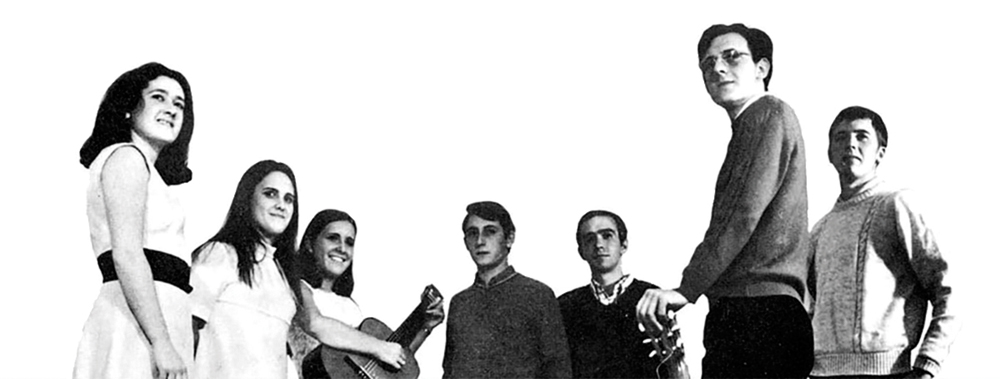Children, lies and myths
- Lying to children is a way to hide from mother's control. But it has temporal validity. Psychoanalyst Donald Winnicott said: “Hiding is nice, but not being discovered, hell.” The starting point of this article is a children's song that talks about the consequences of debunking the mother. It is Kiri-kiri-ken, published in the book Jolasketa, by Aita Onaindia, in 1965, in which Nemesio Etxaniz was the author of the words and the melody (1899 Azkoitia-1982 Donostia). Those of our generation sang at the ikastola in the 1960s and 1970s, sung by the author himself. Later, the group of clowns Txirri and Mirri eta Txiribiton collected it on the album Tortolika, in 1985.

It's not an easy thing in the
Kiri-Kiri,
in the Kiri-Kiri-Kiri, it's not easy to deny the
mother.
He knows everything.
How
do you know?
Kiri calls it
the little finger of the ko-ko-ko!
You tell it all.
This song explains how adults respond when children develop their autonomy and are able to lie. The small wants to be big and the big needs the small. In the rest of Europe, in children's stories and songs, the dialectic of the big and the small is widely used, as well as the relationship between the inhospitable and the omnipotent. In this song, the little finger helps the mother to maintain a seamless wisdom.
In French, the small finger is called “l’auriculaire”, as it has the measure of penetrating into the ear. From there, the little finger has a strong symbolism: it enters through the hole and can talk about secrets and intimacy.
When the child has his own desires and sufficient autonomy to satisfy them, the possibility and necessity of lying is created. It's a lie to say something that doesn't match the truth to trick the person who gets the message. The child must meet two requirements before lying. One, to master reality well without confusing it with fantasy; and another, instead, to invent a substitute that is also real, and not imaginary. Both are the essence of lies.
The motivation to lie is not only conscious, but also unconscious. In this song, for example, there are contradictory feelings related to the mother: on the one hand, she wants to maintain the relationship with the mother and, on the other, the desire to break this bond.
Lying is related to the desire for autonomy. But also with the concern that this creates. Lying means a break with the other. That's why this song avitates. The main theme of children's stories is, on many occasions, getting out of parental dependency. And it shows the regulatory figures. An example of this is the relationship between liar Pinocchio and speaker Kilker, full of conflicts. The cricket is the image of moral consciousness. When the child is small and has a great dependence on the parents, the main references are the parents and their words. But as the child grows, he gets used to the difference between reality and fantasy. Little by little, the child will take distance from those he loves. It will identify with the adults of its environment, thus forming its own personality, while building its own ethics. In this way, it starts to act according to its actions and desires.
I believe that the motto that is stuck in the structure of the song is witness to the indignation of the adult”
This song tells us how complicated the relationship between the child and the mother is. The child has to go a long way until he feels that the body and mind are his. On the path from dependence to autonomy, she experiences intermediate situations ranging from feelings of bonding with the mother to feeling sufficiently detached from her. In this sense, “mom knows everything / mom doesn’t know it” becomes an essential game. On the return trip, reality and fantasy travel. Sometimes the child has not lived sufficiently in these moments of transition. He may have had to adapt too soon by himself, because his affective environment has failed; then the child will build his relationships in a more opposing way. The footprint of the encounter experience with the environment will be maintained forever, becoming a source of trust and well-being in the world and in oneself.
One of the most serious attempts to break the psycho-physical continuity of the child with his mother is the conquest of the no, which can be expressed through the word – among them lies – or behavior. What used to be the continuity between bodies is now going to be between the thoughts, the psychotic bodies of the mother and the baby will communicate with each other, through symbolic language, giving space to lie.
Lying is having an opposite power, because only the child knows what the truth is. And when the lie is addressed to the couple of parents, it questions the reliability of the couple. At the different moments of development, lying appears as an indicator of discomfort. Therefore, even if lying is its functional value, if it becomes repetitive, it will be an indicator of the communication problems the child has with his/her environment.
Swim to
the
Kiri-kiri-ket, if
I swim away.
He knows everything.
How
do you know?
The
little finger of Kiri-kiri-ko-ko!
You tell it all.
The
imaginary part appears in the song's motto, in the adult's answer, when it expresses how it stands before the child's lie. First, the lying of the child causes an unpleasant feeling; the autonomy of the child calls into question the need and dependence of adults so far. The child expresses in lies that he has no intention of being inferior to the adult; lying is a sign of an insurrectional spirit.
I think it is a witness of the indignation of the adult the motto that is stuck in the structure of the song. The adult responds to the child's lie with an incredible fantasy: the mother has a small spy finger that tells her after seeing everything. A little brother, a young vulgar, but more terrible. The adult responds with an overwhelming fantasy, when the mother, like the mythological character, is all-powerful. Next, he tells the child for fear that he will take a step back and that there is a continuity of thought between mother and child. It is fantasy, myth, omnipotent mother, that is not worth avoiding. He will take advantage of the memory that the child has when joining his mother, “we will come together so that there is no tension between us two.” It would be a threat to lose that hope of fusion forever.
But after all, the song is a game. It helps to cope with a situation that can be difficult for the child and for the mother, in general for the adult caregiver, using fantasy. To put it in some way, we know that we will separate, that the world is there with many good things about it. But without a hurry to do that, let's play, let's dream, and in the imagination, we'll always be in continuous monitoring with each other. How difficult it is sometimes to cut the umbilical cord.
Last year, I met a Braham in Delhi. I was surprised that I loved beer and knew it in Spanish. I would say it would be my oldest, but I was walking with the help of a stick, slowly. To see why he knew Spanish, I asked him and he told me that he learned as a child because he heard... [+]
You know how it goes, right? "Dream txuntxurrun green, dream bite...". It is undoubtedly the most famous crib song in Euskera, and also has Vitoria as its protagonist. After a brief study, I learned that Resurrection Mª de Azkue collected in 1922 three versions of the song in his... [+]
Abenduaren 6an agurtu du pilotaren munduak azaroaren 30ean zendutako azkaindarra. Profesional mailan ezker paretan txapela jantzi zuen Ipar Euskal Herriko lehen pilotaria da: bi txapel jantzi zituen binakako txapelketan, Joxan Tolosarekin.
Gasteizko Oihaneder Euskararen Etxearen Batera proiektuen emaitzetarik bat gauzatu du berrikitan Maider Lasak, Malen Iturrirekin elkarlanean. Ekainean aurkeztu zuten Loa, loa, laguna izeneko ikusgarri performatiboa, ahotsez, gorputzez eta irudiz. Tradiziozko lo-kantak oinarri,... [+]
Bost hamarkada baina gehiagoko ibilbidearekin, Oskarbi taldeak badaki zer den egoera zailetan musikaren eta kulturgintzaren haria elikatzea. Ez Dok Amairuren garaietatik gaurdaino, herri kantak eta sormen propioa izan ditu iturri. Hamabigarren diskoa grabatzen ari dira, dozena... [+]
Artzain izan nahi zuen txikitatik, eta artzantzaz bizi da duela hogei urtetik hona. Kantuan aritzea gustuko du eta kantuan ari da etxean bezala plazaz plaza. Ez omen da bizitza idilikoa berea, baina ez omen litzateke beste inon eta beste ezertan zoriontsuago izanen. Urepeleko... [+]
























